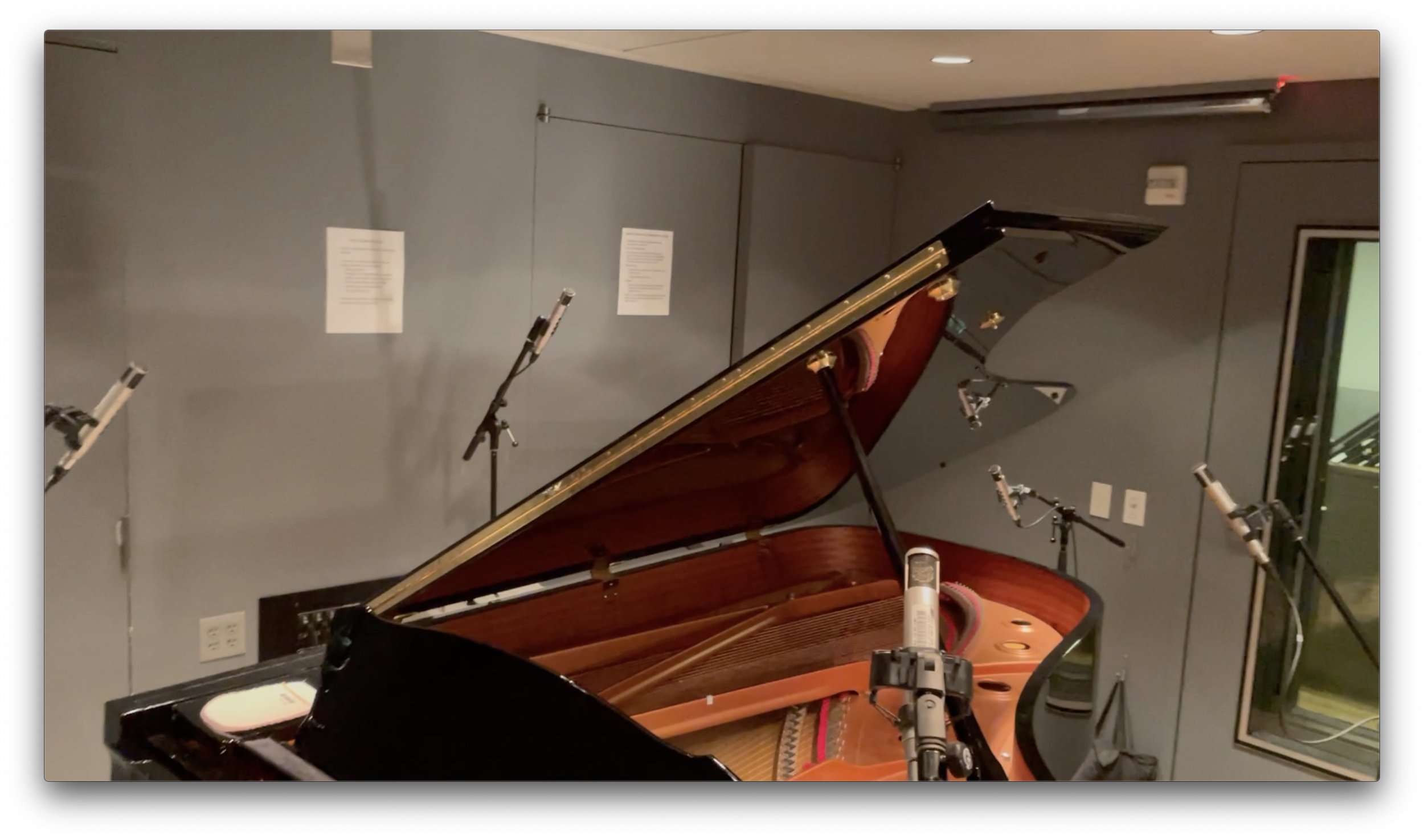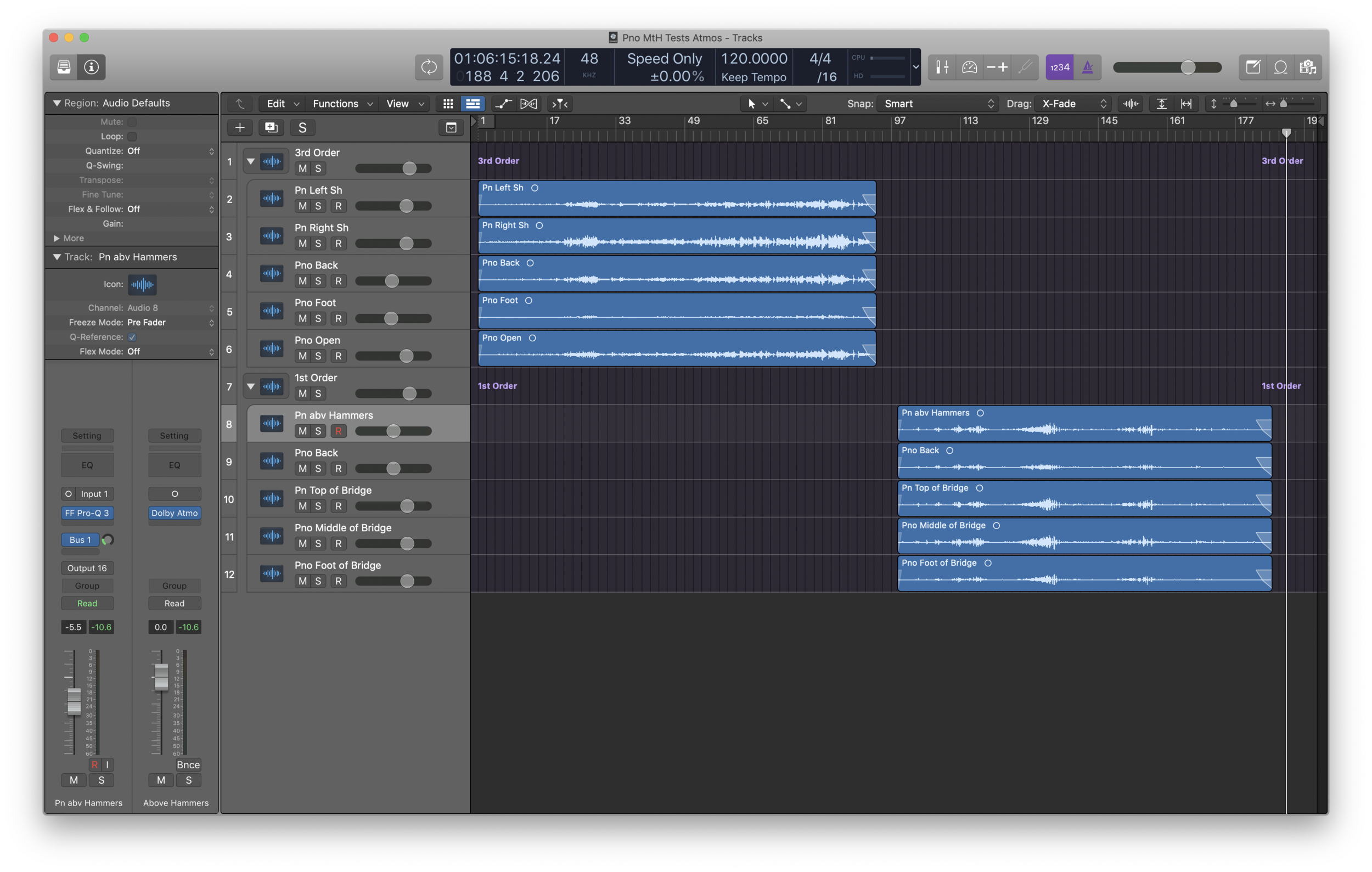MtH Array on Piano
The goal of this session was to further test the MtH Array as a means for an approach for creating Holographic Sound Recordings of any sound source. This session put it up against a piano. Two different MtH Arrays were attempted, one after the other.
The first array attempted was a 3rd order MtH Array, which means it’s five hyper-cardioid microphones set up close to a pentagon formation around the instrument. The other ideas implemented are that each mic is equidistant from a common point, and each mic is placed near an Acoustical Point of Interest; That is, a point of unique, important, and de-correlated sound. The center point is the piece of white tape that was put on the piano’s bridge as you can see in figure 1.
(Figure 1) See the white tape there on the bridge? Each mic was 54 in. away from that point
(Figure 2) 3rd Order sides to the piano
My thinking with using the 3rd order MtH Array was that the radiation pattern of the piano had five sides to it like in figure 2. Each face represents a unique and important sound field. I am going to call these Faces of Radiation for the time being, as this seems to be an aspect of HSRs that is growing in importance to me. You can see how this creates a sort of lop-sided pentagon. The mics were placed facing each face of the pentagon, wherever they made the most acoustical sense to me while also trying to keep them equidistant to the center point.
With the 1st order, the piano radiation was viewed more as a triangle. The line array captured the size of the piano’s harp excellently. But, this design led to a little bit of an issue. Due to the absence of a mic at the position of the foot of the piano, a hole was created in the radiation of this array in Unity. There will be more discussion about how both of these arrays translated into Unity lower on this page. Part of the issue was, in my mind, I was treating this as a 1st order array when in reality it needed to be a 2nd order array, just not near a perfect square. This mistake helped me hone in on the idea of an object’s Faces of Radiation.
(Figure 3) 1st order MtH-Array with Mic Line-Array
Dolby Atmos Re-Renders
The Dolby Atmos Stereo Re-renders are available to listen to on this page below. Keep in mind that these experienced put the listener in the inside of the piano. This is due to the intended experience to be the inverse of this, with the listener walking around the sound sources instead of sitting in the middle of them. The re-renders were created for the sole purpose of providing you with a quick way to experience the recording from your browser. In no way do these accurately represent what the recordings sound like in Unity. To download the recordings as playable applications and listen to them as intended, please visit my itch.io page.
Upon listening to the initial array and consulting my peer Pari Songmuang, we decided to try another approach to the piano. Since the piano is somewhat triangle shaped, we attempted a first order MtH Array with one of the points acting as a microphone line array. In this situation the three points chosen around the piano are behind the performer, behind the lid, and along the length of the harp with the latter acting as the line array point. Due to the length of the piano, much like the Marimba session before, the line array seemed necessary to capture the left-to-right motion of the performance. You can see images of this set up in the collage below.





Below are two videos that explain each array in detail.
Unity Scene
The two arrays were transported into Unity and reassembled around a 3D model of a piano. I wrote code that synced the audio files together and allowed the user to switch between arrays seamlessly. The biggest issue with this session is that we recorded two different pieces with the two arrays, not one piece with both arrays simultaneously. Because of that, the A/B comparison is a little more difficult but I feel like I was still able to make some solid observations from the recorded material.
Unity World with 3D Model of a Piano
3rd Order MtH-Array in Unity from Side
The first array applied was the 3rd order MtH pentagon. This was placed relative to the size of the 3D model of the piano, which was adjusted to feel appropriate to the size of the listener. Each Google Resonance object was set to cardioid. I felt like setting them to hyper-cardioid like I did in the Drum Set MtH session wouldn’t be necessary. That was done so the listener could hear the sound when sitting in the drummers position (which was in the center of all the audio sources). In the case of the piano, the listener is not encouraged to listen from inside of the piano. They would instead listen at a distance from the open lid, or from the piano players position.
From the piano players position, this array gave me a good, wide stereo image compared to the 1st order array. This is probably due to the sound object acting like a wider ORTF that’s facing the listener, whereas the 1st order is a mono audio source pointed directly at the forehead. This makes me believe that thinking about binaural stereo image is important when deciding how to holographically mic an audio source. Another aspect of the radiation this array captured well was the sound coming from the foot of the piano, because of the hole in the 1st order array in this spot, it is obvious that there is a lack of energy when switching between the two arrays in Unity.
3rd Order MtH-Array in Unity from Top
1st Order MtH-Array in Unity from Side
The 1st Order array was laid out respectively to the positions of the microphones in the real world, turned 180º. When listening from the piano players position, it is not as interesting as the 3rd order. Although, when standing in front of the bridge or even at a distance, the amount of energy captured by the mic line-array is much more powerful than the single mic that was used in the 3rd order array. This makes me think that the amount of mics and placement of them should also depend on how large and dynamic each Face of Radiation seems. I think this is a better way to view the application of the MtH-Array. Rather than trying to create perfect shapes, the engineer should identify all the faces and apply however many microphones is necessary to capture that face in an interesting way for the listener.
In hindsight, this piano could’ve been miked with parts of each array. Now that I’ve freed my mind from the enticing aesthetics of mic-arrays with perfect symmetry, I am able to create a holographic mic array that can adapt to any sound object. Next time, I would say that the piano actually has four Faces of Radiation; one at the player’s position, behind the lid, at the foot, and along the bridge. At the players position, I would copy the mics from the 3rd order array that gave a good stereo image to the listener. The microphone behind the lid worked equally well in both scenarios, it’s not an interesting place to stand so one mic did enough. I would also take the mic line-array along the harp from the 1st order array. And lastly, the microphone at the foot of the piano deemed to be important to creating a convincing sonic hologram in the end.
1st Order MtH-Array in Unity from Top




